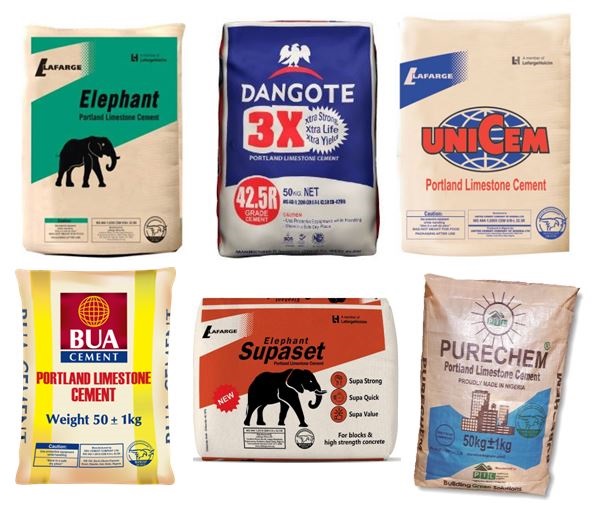Cement, a binding substance used in building and construction industries, is used in buildings which are expected to be exposed to constant high humidity or water. The most common type of cement is Portland cement which may be gray or white while other types include gray Portland cement, the white cement, a less common type, the Pozzolana Portland and the oil well cement. Generally, about 75 per cent of cement produced is used in the construction industry while the remaining 25 per cent is used for paving roads or in oil extraction.

Apart from the difficulty in ensuring food security for its teeming populace, Nigeria is faced with the challenge of providing shelter for the people. This shows the building sector needs a lot of cement to meet this critical social amenity need of a population of about 250 million people.
From available statistics, Nigeria is blessed with a wide range of raw materials used cement production, which are calcium from limestone, silicon, aluminium, iron and gypsum scattered across states in the country. It is on record that limestone formations cut across numerous states such as Abia, Anambra, Bauchi, Bayelsa, Benue, Borno, Edo, Enugu, Imo, Ogun, Ondo and Sokoto. Most of the limestone deposits in Nigeria are high in quality, generally containing over 80 per cent CaCO3.. The shallow water sediments of the albian around Mfammosing contain largest and purest deposit in Nigeria. It is about 50m thick at the quarry site. Over 170 million tonnes of limestone exist in Nkalagu area in Ebonyi State while over 35 million tonnes have been proved in Ewekoro.
More than 80 deposits of clay have been reported in Nigeria. Clay is widely distributed in commercial quantities in Abia, Anambra, Akwa-Ibom, Delta, Gombe, Kaduna, Niger and Ondo states. Gypsum occurrences in Nigeria have been reported since 1921. It is widely distributed in the sedimentary basins of the country, including the Sokoto basin (Sokoto State), Chad basin (Yobe, Borno states), Benue Trough (Adamawa, Taraba, Bauchi and Benue states), the Anambra-Calabar basins (Edo, Kogi, Abia states, etc) and the Dahomey basin (Ogun State).
Speaking exclusively to Science Nigeria, Mr. Sunday Okpe of the Manufacturers Association of Nigeria (MAN) said the availability of mineral raw materials had influenced the establishment of cement industries in Nigeria, adding our large population and large market contribute to the boom of the industry.
According to him, the demand for cement increased rapidly and initially, all requirements were met with imports with the establishment of Nigercem, Ewekoro and Bendel Cement and the Cement Company of Northern Nigeria all being in response to the increasing demand. He said post-war reconstruction also led to establishment of second-generation cement plants such as Shagamu plant, Ashaka and Benue Cement Company, all the companies having government ownership and control.
He explained that the backward integration programme embarked on in 2002, however, encouraged establishment of cement plants by private investors. Since 2002, the Nigerian cement sector has metamorphosed from being import-dependent to a growing hub for cement export in Africa. The installed capacity has expanded to outstrip estimated demand, with government policies such as tax relief programs and ban on cement importation among others, encouraging capacity expansion among players.
He affirmed that although controversies over pricing and imports have been an issue of concern, local cement output had increased at a remarkable rate in the past decade, largely due to the introduction of the Backward Integration Policy (BIP), which helped drive up production capacity from 2m tonnes in 2002 to 50m tonnes at the end of 2019. The industry now employs around 2m people directly and indirectly and has attracted $6bn in investment. The policy is saving Nigeria around N210bn ($1.3bn) annually in foreign exchange equivalent.
“At present, the Nigerian cement industry has three major players with Dangote Cement Plc having the major market share of 60.6 per cent with an installed capacity of 29.3 million MT; Lafarge Africa Plc has 21.8 per cent share with 10.5 million MT and BUA Group accounts for 17.6 per cent share with 8 million MT. There are also other small players like Purechem Industries with 900,000 MT. Today, the country exports cement although a small quantity is still being imported. The value of exports of Portland cement, from Nigeria totalled $38 million in 2019 and this constituted 0.071 per cent of total exports while the value of imports of Portland cement the same year was $4.58,” he said.
Okpe averred that the major drivers of increased demand for cement in Nigeria is housing construction and infrastructure development, saying the crucial forces on the demand for residential housing are population pressure and the rent level.
According to him, the housing deficit in Nigeria is estimated at 17 million new affordable homes. He gave the major factors responsible for high cement prices as the cost of energy/power which is substantially high in the country.
He recounted that the high initial setup capital and operating costs led to closure of companies such as Eastern Bulkcem and Ibeto Group, adding the erratic power supply, poor state of infrastructure, cost of haulage of primary raw materials, the distribution cost of finished cement, technology inadequacies and foreign exchange instability are militating against optimal performance of the industry.
“Other militating factors are unfavourable government policies such as the privatization of previously government-controlled cement companies which led to their collapse due to underfunding, government’s ban and subsequent lifting on importation of cement and the imposition of multiple taxes. All these need to be looked into through favourable policy shift in order to realise the full potentials and vibrancy of the sector. Consequently, the policy on backward integration should be extended to other industrial sectors to motivate increased capacity utilization in the sectors,” he added.
Speaking on the interventions of the council in charge of promoting raw materials development in Nigeria – the Raw Materials Research and Development Council (RMRDC) in salvaging the cement production challenge in Nigeria, its director-general, Prof. Hussaini Ibrahim, said RMRDC since inception had recognized the need for the development and utilization of Nigeria’s mineral resources for sustainable development.

“It is on record that as at 1992, there were only two solid mineral processing companies in Nigeria, namely Kavitex in Jos and F and G in Ikorodu, Lagos, despite the fact that the various surveys coordinated by the council indicated abundant availability of a variety of mineral resources locally and in sustainable quantities. As a result, the council convened a national investors’ forum to promote industrial processing of the minerals. Following the forum in Abuja and subsequent follow-up actions, some indigenous companies came on stream, e.g. Purechem commissioned a mini cement plant in 1996. By 2006, about 35 solid mineral processing companies were established in various states of the federation processing kaolin, calcite limestone, phosphate, barite, talc and dolomite,” he said.
The RMRDC boss stated that as at 2002, the annual national demand for cement was over 10 MT, while local production was about 2 million MT, saying the short fall was met through importation of cement in bulk/bags. With the support and concerted efforts in promoting investments, Nigeria has achieved self-sufficiency in cement production with potential to export. Today the country produces over 50 million MT/annum.
“Through the collaboration of RMRDC and Brewtech, some state governments such as Sokoto, Gombe, Kebbi are in the forefront to promote establishment of mini cement factories. These would have been realized if not for change in government. In addition, a number of private sector investors have also keyed into this initiative and mini cement plants will soon make its debut in Oyo, Ogun and Kwara states.
“The primary objective of promoting the establishment of mini cement plants in Nigeria is to reduce capital cost of cement industries establishment, reduce the price of cement and create job opportunities and wealth in the country,” he said.
To promote optimal use of local raw materials in the cement industry, he pointed out that his agency had worked assiduously on the development of limestone and gypsum minerals locally.
The efforts of RMRDC and those of other relevant MDAs, Ibrahim said had led to the documentation and publication of both limestone and gypsum deposits in the country with most of them characterised and classified. Other major areas RMRDC has contributed to the sustainable development of limestone in recent times, according to him, is in the design, fabrication and installation of granulated limestone processing plant in Calabar, Cross River State; the development, fabrication and installation of hydrated lime production plant in Kwakuti, Niger State in collaboration with Bembu Mining and Engineering Services Ltd, and the development, fabrication and installation of hydrated lime production plant in National Research Institute of Chemical Technology (NARICT), Zaria.
The RMRDC helmsman further said the council in partnership with an established private entrepreneur went into a joint venture arrangement and incorporated a company named Finestones Processing Nigeria Ltd located in Calabar, Cross-River State, for the processing of granulated limestone for fertilizer blending purposes. He said the plant has an installed capacity for the production of 20,000 tonnes of granulated limestone per annum. The production process employed in the Calabar plant involves very simple operations, requiring the following components: limestone ore bin, jaw crusher, hammer mill, conveyor belt, classifier, sieve, granulator and bagging machine, he stated, adding the agency had divested from the project and it is now completely owned by the private sector collaborator.
“Likewise, the council has worked extensively on improving and developing the quality of gypsum in Nigeria. The estimated quantity of gypsum required in the cement industry in the country stands at 2.1million on annual basis at 5 per cent usage. The demand far outweighs the supply capabilities of domestic mining. The gap has always been abridged by importation.
“As a result of this, the council designed, developed and fabricated a 30 tonnes per day gypsum scrubber/washer, for the beneficiation of Gypsum for POP and cement manufacturing. The washer had been commissioned. Replicates of this are being made for use by gypsum miners associations in endowed states in the country. This will facilitate the production concrete for road construction in the country apart from its influence on job creation,” he added.


